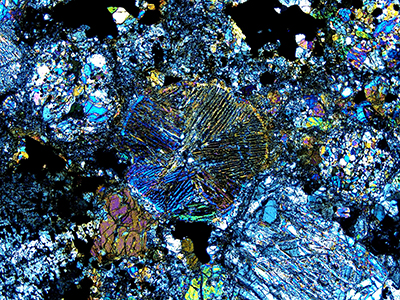Chaotic Early Solar System Collisions Resembled ‘Asteroids’ Arcade Game
News

Chaotic Early Solar System Collisions Resembled ‘Asteroids’ Arcade Game
One Friday evening in 1992, a meteorite ended a more than 150-million mile journey by smashing into the trunk of a red Chevrolet Malibu in Peekskill, New York. The car’s owner reported that the 30-pound remnant of the earliest days of our solar system was still warm and smelled of sulfur.
Nearly 30 years later, a new analysis of that same Peekskill meteorite as well as 17 others by researchers at the University of Tennessee, Knoxville (UT), and The University of Texas at Austin has led to a new hypothesis about our solar system’s early years — and they weren’t peaceful.
Michael Lucas, postdoctoral scholar in the UT Department of Earth and Planetary Sciences, lead the study, which was published in the journal Geochimica et Cosmochimica Acta Dec. 1, 2020.
“Working on the petrology and geochemistry of meteorites is like being a historian,” Lucas said. “The silicate minerals in these stony meteorites serve as miniature thermometers that enable us to probe what temperatures the parent body of the meteorites experienced long ago. If you apply several of these mineral thermometers to the same meteorite, then you can infer information regarding the thermal history of the original body dating back to the first few 10’s of millions of years of solar system history.”
Co-author Nicholas Dygert, assistant professor in the UT Department of Earth and Planetary Sciences, began this research as a postdoctoral fellow at the University of Texas at Austin’s Jackson School of Geosciences. Using a rare earth element (REE)-in-two-pyroxene thermometer, Dygert measured the cooling rates of terrestrial rocks, but realized it could work for space rocks, too.
“A big part of making this work possible was coming to UT,” Dygert said. “I brought with me a really powerful new technique for using geochemistry to understand geophysical processes, but had almost no prior experience working on meteorites.”
Luckily for Dygert, faculty in the department included two pioneers in the field of petrology and geochemistry of extraterrestrial materials: Hap McSween, Chancellor’s Professor Emeritus in Earth and Planetary Sciences, and the late Professor Larry Taylor. In addition, one of the two major instruments used in the research – an electron microprobe – is housed in a laboratory in the UT Department of Earth and Planetary Sciences.
“Thanks to the guidance of coauthor Hap McSween, a legend in the meteoritics community, I was able to collect seed data, write a successful proposal, and hire Michael, the lead author of our study who also has a strong background in meteoritics thanks to a PhD at UT.”
Since the 1970s, scientists have been measuring minerals in meteorites to tease out how they formed. The work suggested that meteorites cooled very slowly from the outside inward in layers. This “onion shell model” is consistent with a relatively peaceful young solar system where chunks of rock orbited unhindered. Those studies, however, were only capable of measuring cooling rates from temperatures near about 500 degrees Celsius or lower. When Dygert and Lucas applied the REE-in-two-pyroxene method, with its much higher sensitivity to peak temperature, they found unexpected results. From around 900 degrees Celsius down to 500 degrees Celsius, cooling rates were 1,000 to 1,000,000 times faster than at lower temperatures.
How could these two very different cooling rates be reconciled?

The scientists proposed that asteroids formed in stages. If the early solar system was rife with bombardment, much like the old Atari game “Asteroids,” large rocks would have been smashed to bits. Those smaller pieces would have cooled quickly. Afterwards, when the small pieces reassembled into larger asteroids we see today, cooling rates would have slowed.
To test this “rubble pile hypothesis,” Professor Marc Hesse and first-year doctoral student Jialong Ren with the University of Texas at Austin Jackson School of Geosciences, built the first computational model of a two-stage thermal history of rubble pile asteroids. Due to the vast number of pieces in a rubble pile —1015 or a thousand trillions — and the vast array of their sizes, Ren had to develop new techniques to account for changes in mass and temperature before and after bombardment.
The resulting model supports the rubble pile hypothesis. Another finding is that cooling slowed after reassembly because the rubble pile contained pores and not because the rock gave off heat in layers.
“The porosity reduces how fast you can conduct heat,” Hesse said. “You actually cool slower than you would have if you hadn’t fragmented because all of the rubble makes kind of a nice blanket. And that’s sort of unintuitive.”
As a result of using this new model, the team was able to demonstrate quantitatively their physical interpretation of meteorite parent asteroids satisfies the geochemical constraints.
“Our research informs a longstanding debate about the thermal structure of meteorite parent asteroids, which relates to the collisional history of the early solar system,” Dygert said. “We corroborated our findings with an independent method, so they appear to be pretty solid.
”The biggest implication of the new rubble pile hypothesis, Dygert said, is that these collisions characterized the early days of the solar system.
“They were violent, and they started early on,” he said. Dygert and Lucas will continue their work on several meteorite groups from other parent asteroids.
“Our preliminary data indicate that at least one more parent body had a similar history to the ordinary chondrite asteroids, suggesting that these early catastrophic collisions were frequent in the early solar system,” Dygert said. “It will be interesting to interface with people in the orbital dynamics community to provide new inputs to models of planetary accretion, because one of the important constraints in their models is the frequency of collisions in the early solar system.”
This work was supported by NASA. The Smithsonian National Museum of Natural History supplied samples of meteorites for the study.